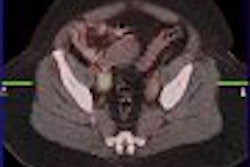Combining SPECT and CT into a single hybrid modality can improve physicians' views of bone scans, as well as the confidence levels of their own diagnoses. Two recent studies are showing SPECT/CT's value in managing cancer patients and patients with back pain.
The first study was part of a pilot project based at South Street Hospital in London, Ontario, to evaluate the performance of hybrid low-dose (less than 2 mSv of radiation) multislice CT and SPECT in the management of patients undergoing bone scans.
Researchers used an Infinia Hawkeye 4 SPECT/CT system from GE Healthcare of Chalfont St. Giles, U.K. The study included 51 consecutive patients: 34 were explored for suspicion of bone metastases from a known malignancy, while the other 17 patients had undetermined bone pain with no context of cancer at the time of the SPECT/CT scan.
The analysis was performed by one nuclear medicine physician and one radiologist with experience in musculoskeletal disease. The final interpretation was determined by consensus by comparing the reading protocol from the SPECT/CT and correlating with available clinical data and diagnostic CT and MRI results. A predefined template was used to score the added value of SPECT/CT.
The study also included a subset of patients who had a full-time SPECT acquisition of 30 seconds of interpretation over one field-of-view, with other patients having half-time acquisition of 16 seconds of interpretation over two fields-of-view.
Varying fields-of-view
For the half-time acquisitions, three-quarters of the patients in the study had acquisitions over two fields-of-view, covering the entire spine in less than 30 minutes. Total time included the CT scan.
In 39 of 51 patients, half-time bone evolution SPECT acquisitions of 10 minutes per field-of-view, followed by CT acquisitions of four minutes per field-of-view were performed over two fields-of-view, allowing scanning of the entire spine in less than 30 minutes.
In terms of image quality, Dr. Tarik Belhocine, who co-authored the study and presented the results at the 2007 SNM meeting in Washington, DC, noted that reconstruction with bone evolution -- either in one field-of-view or two fields-of-view -- show improved image quality compared with ordered-subsets expectation maximization (OSEM) or filtered back projection (FBP).
The CT quality for detecting and characterizing degenerative spine disease and osteolytic/blastic, metastatic lesions was characterized as good in 92% of the cases.
Heightened confidence
Within the study's subset of cancer patients, the clinical implications from SPECT/CT found that the hybrid modality "improved the interpretation confidence (82% of the cases), improved the specificity, allowed better anatomy localization, and led to the detection of morphological lesions, benign lesions, and spine or musculoskeletal disease," Belhocine noted.
SPECT/CT also was found useful for directing further follow-up in 19 of 51 cases, or 37%, especially in patients being investigated for joint pains, such as knees and hips, or lower back pain. In 64% of the cases (11 of 17), MRI was found to be more appropriate for characterizing benign bone diseases.
Multislice, low-dose SPECT/CT was "of incremental value for bone scans, for improving interpretation confidence, for final or faster diagnosis in a number of cases, and for appropriate guidance in further workups," Belhocine concluded.
From previous studies, SPECT alone has demonstrated more sensitivity than conventional planar bone scanning for detecting bony lesions in patients with back pain.
Lesion localization
For the second study presented at the SNM meeting, researchers at the Mount Sinai School of Medicine in New York City set out to determine to what degree SPECT/CT could provide enhanced anatomical localization of the lesions detected by SPECT, specifically as it relates to bone scanning and evaluating patients with back pain.
The group analyzed bone scans from 80 patients (34 men, 46 women) with back pain. Planar, SPECT, and SPECT/CT images from those patients were evaluated for bony lesion presence, location, and individual diagnosis based on each scan. In all, 159 lesions were discovered in the 80 cases, with final diagnoses that ranged from arthritis, degenerative disease, and fracture to osteomyelitis and normal bones.
Among the findings, researchers determined that SPECT/CT was more accurate in predicting the diagnosis than SPECT alone. Study co-author Dr. Sherif Heiba noted in his SNM presentation that in so-called "uncertain" and "probable" lesion sites on planar images, localization certainty was significantly higher with SPECT/CT than SPECT alone.
"SPECT/CT added significant improvement in the diagnostic ability of SPECT by reclassifying 93 of 104 lesions from being 'probable' to 'certain,'" Heiba added.
In comparing SPECT and planar images, SPECT alone significantly improved the certainty of lesions. SPECT/CT's most significant contribution is clarifying the extent of the exact location of lesions.
By Wayne Forrest
AuntMinnie.com staff writer
September 21, 2007
Related Reading
Duke MMIL designs novel SPECT/CT system for 3D breast imaging, July 18, 2007
Israeli group test-drives 64-slice SPECT/CT system for cardiac imaging, June 6, 2007
SPECT/CT offers on-target diagnosis in noncancerous bone disease, March 23, 2007
SPECT/CT improves sentinel node detection in overweight breast cancer patients, February 14, 2007
SPECT/CT enhances octreotide imaging, January 12, 2007
Copyright © 2007 AuntMinnie.com



















